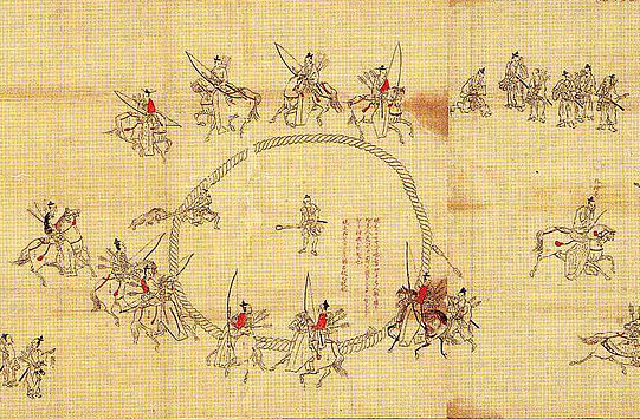Samurai tradition stresses the importance of horse and rider as one, but this canine contest is completely for comedy.
Because of Japan’s rich linguistic heritage and unique cultural perspectives, Japanese-language philosophical terms have an allure and cachet that extends beyond the country’s borders. For example, the words kaizen and omotenashi often get used even by non-Japanese speakers when discussing Japan’s ideals of continuous improvement or hospitality.
The phenomenon is a point of pride for many Japanese people, so Japanese Twitter user @NJRecalls probably thought of it as a feather in his country’s cap when he was watching a foreign TV show in which the term jinba ittai came up. Meaning “horse and rider as one body,” jinba ittai originates in yabusame, Japanese horseback archery, and describes a skilled rider’s ability to control his steed as though it were an extension of his own body, but it’s also the driving design theme for Mazda’s Roadster/Miata/MX-5 sports car, which is what the foreign TV show’s segment was about.
真実と嘘の二段構えで来るのやめろ pic.twitter.com/4lCZN0veSK
— NJRecalls (@NJRecalls) February 29, 2020
However, after explaining jinba ittai, the foreign program’s presenter introduced another term: beati dogu, which he described as “Japanese for the ancient art of driving a sports car around a greyhound track faster than a dog.” @NJRecalls was less impressed with another part of the Roadster report, and tweeted:
“Stop stacking lies on top of the truth.”
It turns out, though, that this is as much a case of a pop cultural misunderstanding as it is a traditional cultural one. As seen in the video here, the program @NJRecalls was watching was…
…Top Gear, the British motoring program that’s at least as focused on putting its tongue in its cheek as it is the pedal to the metal. That’s co-host Richard Hammond drifting the NC (third-generation) Roadster around the dog track, and his presentation of the term “beati dogu” (i.e. “beat dog”) makes it pretty obvious that it’s meant as a joke.
Oddly enough, though, there is a connection between yabusame and dogs. A one commenter pointed out, back in the Kamakura period (which started in the late 12th century), there used to be a sport called inuoumono, in which mounted archers would ride around an enclosure firing arrows at dogs on the inside.
▼ Somehow, I doubt this is going to be the next minor Japanese sport to get turned into a hot-blooded teen athletes anime.
The inuoumono/yabusame/jinba ittai/beati dogu connection looks to be a pure coincidence, though, and a simple matter of Top Gear wanting a humorous excuse to drive a car on a dog track.
That said, there is one thing to get your linguist feathers ruffled over, if you’re so inclined. First, the Japanese language contains no “ti” sound, so if you’re going to approximate the word “beat” in Japanese, it should sound closer to “beato” than “beati.” Ultimately, though, like with the pseudo-Japanese seen in the live-action Ghost in the Shell and Avengers Endgame filming, accurate linguistics weren’t really Top Gear’s aim.
Source: Twitter/@NJRecalls via Hachima Kiko
Insert image: Wikipedia/ブレイズマン~commonswiki
● Want to hear about SoraNews24’s latest articles as soon as they’re published? Follow us on Facebook and Twitter!
Follow Casey on Twitter for more about is love of Mazda sports cars and Japanese linguistics.


 We revisited Sweets Paradise after a decade to see if Japan’s dessert buffet still delivers
We revisited Sweets Paradise after a decade to see if Japan’s dessert buffet still delivers That time Seiji called JASRAC to ask why he didn’t get paid royalties for his song being on TV
That time Seiji called JASRAC to ask why he didn’t get paid royalties for his song being on TV Cup Noodle tries an authentic Jiro-style ramen, but something’s not quite right
Cup Noodle tries an authentic Jiro-style ramen, but something’s not quite right 7 great places to see Mt. Fuji from without having to climb it
7 great places to see Mt. Fuji from without having to climb it McDonald’s Japan has free smiles on its delivery menu, but does asking for one make a difference?
McDonald’s Japan has free smiles on its delivery menu, but does asking for one make a difference? We revisited Sweets Paradise after a decade to see if Japan’s dessert buffet still delivers
We revisited Sweets Paradise after a decade to see if Japan’s dessert buffet still delivers That time Seiji called JASRAC to ask why he didn’t get paid royalties for his song being on TV
That time Seiji called JASRAC to ask why he didn’t get paid royalties for his song being on TV Cup Noodle tries an authentic Jiro-style ramen, but something’s not quite right
Cup Noodle tries an authentic Jiro-style ramen, but something’s not quite right 7 great places to see Mt. Fuji from without having to climb it
7 great places to see Mt. Fuji from without having to climb it McDonald’s Japan has free smiles on its delivery menu, but does asking for one make a difference?
McDonald’s Japan has free smiles on its delivery menu, but does asking for one make a difference? In downtown Tokyo, we talk to a guy who says he’s from Orion’s belt, get called an “idiot”
In downtown Tokyo, we talk to a guy who says he’s from Orion’s belt, get called an “idiot” Pizza Hut Japan’s hot lucky bags are perfect for a New Year’s pizza party
Pizza Hut Japan’s hot lucky bags are perfect for a New Year’s pizza party Japanese gamer furniture company creates cabinets just for collectible trading card gamers【Pics】
Japanese gamer furniture company creates cabinets just for collectible trading card gamers【Pics】 More than one in three Japanese working women in survey would rather be housewives
More than one in three Japanese working women in survey would rather be housewives Eat Kuroge Wagyu beef at this Japanese restaurant in Ginza for less than 10 bucks!
Eat Kuroge Wagyu beef at this Japanese restaurant in Ginza for less than 10 bucks! Starbucks Japan ready to get Year of the Horse started with adorable drinkware and plushies【Pics】
Starbucks Japan ready to get Year of the Horse started with adorable drinkware and plushies【Pics】 Cyberpunk anime meets traditional culture in Ghost in the Shell gold leaf Japanese changing screens
Cyberpunk anime meets traditional culture in Ghost in the Shell gold leaf Japanese changing screens Hello Kitty Choco Egg figures are an adorable trip through three periods of Japanese pop culture【Pics】
Hello Kitty Choco Egg figures are an adorable trip through three periods of Japanese pop culture【Pics】 7-Eleven Japan’s ramen-cooking robot whipped us up a bowl of noodles【Taste test】
7-Eleven Japan’s ramen-cooking robot whipped us up a bowl of noodles【Taste test】 We found possibly the quietest Japanese-style hotel in Tokyo’s bustling Shinjuku district
We found possibly the quietest Japanese-style hotel in Tokyo’s bustling Shinjuku district Japan’s otoshidama tradition of giving kids money at New Year’s gets a social welfare upgrade
Japan’s otoshidama tradition of giving kids money at New Year’s gets a social welfare upgrade Sumo Sanrio! Hello Kitty and pals team up with Japan Sumo Association for new merch【Pics】
Sumo Sanrio! Hello Kitty and pals team up with Japan Sumo Association for new merch【Pics】 More Than a Capsule Stay: Why Solo Travelers Choose “global cabin Yokohama Chinatown”
More Than a Capsule Stay: Why Solo Travelers Choose “global cabin Yokohama Chinatown” Japan’s oldest largetooth sawfish in captivity back on display in Mie Prefecture
Japan’s oldest largetooth sawfish in captivity back on display in Mie Prefecture 7-Eleven Japan starts new temporary luggage storage service in over 300 branches
7-Eleven Japan starts new temporary luggage storage service in over 300 branches Disillusionment at Tsukiji’s tourist-target prices led us to a great ramen restaurant in Tokyo
Disillusionment at Tsukiji’s tourist-target prices led us to a great ramen restaurant in Tokyo Starbucks teams up with 166-year-old Kyoto doll maker for Year of the Horse decorations【Photos】
Starbucks teams up with 166-year-old Kyoto doll maker for Year of the Horse decorations【Photos】 Tokyo considering law requiring more trash cans following litter increase in heavily touristed area
Tokyo considering law requiring more trash cans following litter increase in heavily touristed area Tokyo’s Tsukiji sushi neighborhood asks tour groups to stay away for the rest of the month
Tokyo’s Tsukiji sushi neighborhood asks tour groups to stay away for the rest of the month Tokyo event lets you travel back in time, for free, to celebrate 100 years since Showa era start
Tokyo event lets you travel back in time, for free, to celebrate 100 years since Showa era start Sanrio theme park in Japan announces plans to expand into a Sanrio resort
Sanrio theme park in Japan announces plans to expand into a Sanrio resort Japan may add Japanese language proficiency, lifestyle classes to permanent foreign resident requirements
Japan may add Japanese language proficiency, lifestyle classes to permanent foreign resident requirements Stamina-destroying “Paralysis Noodles” are Tokyo’s newest over-the-top ramen innovation
Stamina-destroying “Paralysis Noodles” are Tokyo’s newest over-the-top ramen innovation Survey asks foreign tourists what bothered them in Japan, more than half gave same answer
Survey asks foreign tourists what bothered them in Japan, more than half gave same answer Japan’s human washing machines will go on sale to general public, demos to be held in Tokyo
Japan’s human washing machines will go on sale to general public, demos to be held in Tokyo Japan’s deadliest food claims more victims, but why do people keep eating it for New Year’s?
Japan’s deadliest food claims more victims, but why do people keep eating it for New Year’s? We deeply regret going into this tunnel on our walk in the mountains of Japan
We deeply regret going into this tunnel on our walk in the mountains of Japan Studio Ghibli releases Kodama forest spirits from Princess Mononoke to light up your home
Studio Ghibli releases Kodama forest spirits from Princess Mononoke to light up your home Major Japanese hotel chain says reservations via overseas booking sites may not be valid
Major Japanese hotel chain says reservations via overseas booking sites may not be valid Put sesame oil in your coffee? Japanese maker says it’s the best way to start your day【Taste test】
Put sesame oil in your coffee? Japanese maker says it’s the best way to start your day【Taste test】 No more using real katana for tourism activities, Japan’s National Police Agency says
No more using real katana for tourism activities, Japan’s National Police Agency says Starbucks Japan reveals new sakura drinkware collection, inspired by evening cherry blossoms
Starbucks Japan reveals new sakura drinkware collection, inspired by evening cherry blossoms Updated cherry blossom forecast shows extra-long sakura season for Japan this year
Updated cherry blossom forecast shows extra-long sakura season for Japan this year In downtown Tokyo, we talk to a guy who says he’s from Orion’s belt, get called an “idiot”
In downtown Tokyo, we talk to a guy who says he’s from Orion’s belt, get called an “idiot” Pizza Hut Japan’s hot lucky bags are perfect for a New Year’s pizza party
Pizza Hut Japan’s hot lucky bags are perfect for a New Year’s pizza party Japanese gamer furniture company creates cabinets just for collectible trading card gamers【Pics】
Japanese gamer furniture company creates cabinets just for collectible trading card gamers【Pics】 More than one in three Japanese working women in survey would rather be housewives
More than one in three Japanese working women in survey would rather be housewives Eat Kuroge Wagyu beef at this Japanese restaurant in Ginza for less than 10 bucks!
Eat Kuroge Wagyu beef at this Japanese restaurant in Ginza for less than 10 bucks! 100-year-old brush shop in Tokyo sells a Japanese body brush that’s painfully good
100-year-old brush shop in Tokyo sells a Japanese body brush that’s painfully good Dragon Quest Burgers and Slime drinks are coming to McDonald’s Japan【Video】
Dragon Quest Burgers and Slime drinks are coming to McDonald’s Japan【Video】 Large amount of supposed human organs left in Osaka marketplace
Large amount of supposed human organs left in Osaka marketplace Evil barbershop punished by heroic copyright agency for playing stereo
Evil barbershop punished by heroic copyright agency for playing stereo Starbucks Japan brings sakura sweets to the table for cherry blossom season 2024
Starbucks Japan brings sakura sweets to the table for cherry blossom season 2024 Pokémon fans aren’t happy with the Mister Donut fukubukuro lucky bag for 2025
Pokémon fans aren’t happy with the Mister Donut fukubukuro lucky bag for 2025 Hello Kitty Choco Egg figures are an adorable trip through three periods of Japanese pop culture【Pics】
Hello Kitty Choco Egg figures are an adorable trip through three periods of Japanese pop culture【Pics】
Leave a Reply